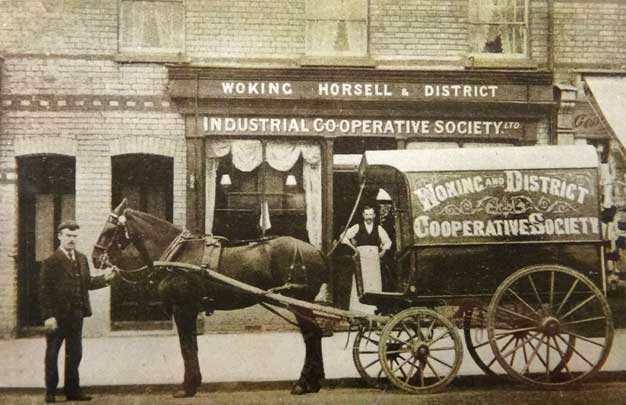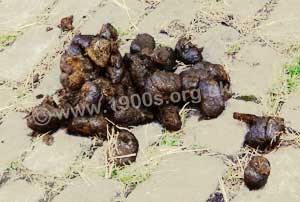How to grow vegetables and plants organically - the old way
With the current concern about saving the planet, more and more people are trying to 'go green' by growing their own vegetables organically. A helpful guideline, where feasible, is to do it the way our ancestors did. This page describes growing potatoes and other vegetables the old way. The focus is not new. It came to the fore during WW2 when one of the spearheads of the Government campaign to make Britain more self-sufficient for food was to encourage the public to grow vegetables in their gardens and allotments.
____
By the webmaster based on firsthand recollections and additional research
Growing potatoes
Seed potatoes
Potatoes were normally grown from what were called 'seed potatoes' although they were not actually seeds. They were small potatoes collected from the best of the previous year's crop. Today, seed potatoes are widely available from garden centres and online, but it was not always so. Peter Johnson describes how the public could buy seed potatoes during the rationing and shortages of World War Two, which was probably similar in Victorian times. Then, though, the problem was not rationing but poverty.
Planting potatoes
Planting the seed potatoes was normally done by what was called the 'trench and earth up' method. Essentially the ground was cleared of weeds and dug over to loosen the soil. Then straight trenches were dug about 6 inches deep and around 2 to 3 feet apart. The seed potatoes were then distributed along the trenches at a separation of a couple of feet. Earth was then raked over the potatoes and they were left to start growth. As the potato shoots grew and began to show themselves, earth was raked to cover about half way up the new shoots. This was called 'earthing up', and it was repeated a number of times as the shoots kept growing. Eventually, characteristic ridges were produces. Inside the soil, the potato roots were spreading and tubers, that is new potatoes, were forming under the soil.
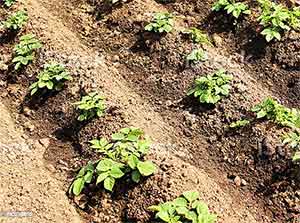
Potato plants, earthed up making characteristic trenches
Planting and harvesting new potatoes
New potatoes were a different variety from main crop ones. My memory is that most people preferred the waxy over the floury ones. They were planted as described above between March and April and dug up around June to July. They were delicious fresh but tended to be of varieties that wouldn't keep well, which meant that they were best dug just a day or two before use. Those plants not required straight away were left in the ground until needed, as this kept them in the best condition.
Main Crop Potatoes
My mother's preferred variety in the 1940s and 50s was King Edward, a variety selected for its keeping quality. The seed potatoes too were planted as described above but a couple of months later than the new variety. They were harvested around September or October, and made delicious roast potatoes for accompanying the Sunday roast.
Growing vegetables and flowers
Whereas potatoes, beans and some flower seeds were sown directly into the ground, other vegetable and flower seeds needed special care to germinate and grow on. They were sown in special compost in seed trays or tiny pots.
Seed trays
There were no plastic seed trays before the mid 1950s. Seed trays were made of cheap wood, and many such trays are in the shops now due to the green revolution. Plastic trays can of course still be green where they can be reused from year to year.
Seed and plant pots
Some seeds were sown directly into pots, all of which were made of clay before the advent of plastic. In order to get as many of these as possible into a small space, pots for small seeds were tiny and known as 'thumbs'. They measured only about 3 cm at their widest point.
All the pots were produced in potteries, located in areas of naturally occurring clay. Potteries were once common sights, but as plastic took over from clay, they either went out of business or turned their attention to the large decorative pots, sold in garden centres as terracotta.
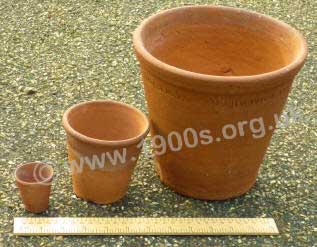
Three clay pots of increasing size. The smallest, known as a 'thumbs' was for very young seedlings. The ruler is a foot long, ie 30.48 centimetres.
Clay pots had advantages over today's plastic ones. They were porous which was said to be good for seeds and plants because it allowed them to 'breathe', although the value of this is open to question in view of the later success of plastic flower pots. It was possibly a marketing ploy in an attempt to maintain sales.
Yet few people would choose clay pots over plastic ones today, other than for aethetic reasons. Their disadvantages included being heavier than plastic ones and being so brittle that they broke easily. Also, because they were produced in such quantity, they were normally made from rough clay which still had bits of grit in it. This made the surface uneven, so trapping water which, when it turned to ice in freezing conditions, expanded and caused cracking.
So clay pots had to be cared for and stored somewhere away from frost. Plastic pots were and still are resilient.
Compost for seeds
Seed compost needs to be fine and free of lumps. Today, it can be bought from garden centres and even online, but in the past people were generally creative in making their own.
Here, for your interest, are some of the ways that people used to make their seed compost, although today's green enthusiasts would probably think the effort was a step too far.
- Worm casts were collected and sifted because the worms had done the hard work of breaking up the soil.
- The silt that collected in gutters and at the sides of roads was also collected and used.
- The soil from mole hills, when and where available, was used as the moles had done the work of breaking the soil up.
The resulting material was either used alone or added to sifted garden soil. A garden sieve was a common garden tool. It was always rusty, having been used in damp conditions in the open, but the plants didn't seem to mind.
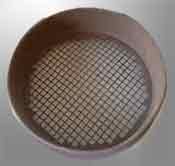
Rusting metal garden sieve
Growing seedlings on
As the seedlings grew, they were moved into progressively larger clay pots until it was time for them to go into open ground.
There was no shortage of broken pottery to use as 'crocks' for drainage in the larger pots because many of the previous years' pots would have been broken up by frost or accidental knocking.
Free manure and rain water
contributed by Peter Johnson, early recollections
Horse manure
In the past, there was an unwritten law that if the horse was outside your house when it did his business, then that belonged to you. It was an excellent source of manure, as most things were delivered by horse drawn vehicles. So everybody had a shovel and bucket ready for action. As a horse came down the street, everybody would be waiting see if it did its business. If it did outside your house, it was rather like winning the lottery.
Rain water
Most people had a water butt in the back garden. This was either an old beer barrel or an oil drum arranged to catch rain water draining from the roof.
Liquid fertiliser
The fresh horse manure was put into an old sack and suspended in the water. The result was a deep brown liquid similar to Baby Bio plant feed and was later put onto the soil with a tin watering can - again, no plastics.

Old garden barrel for water or home-made liquid fertiliser from horse droppings
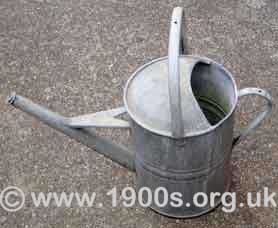
Old tin watering can used before the advent of plastics
Urine
Something that was common but never spoken of in history books was the use of urine. Most people had a bucket in the air raid shelter, or a chamber pot under the bed. Urine was collected to be diluted and watered around the base of growing vegetables. Many parts of the world such as China still do this on a vast scale. Even today people put diluted urine on their lawns to obtain a fantastic green colour.
I just remember my mother collecting horse droppings, as described by Peter Johnson. This was while the dairy still delivered by horse and cart.
Compost for soil improvement
It was normal to have a compost heap or bin in the garden. Vegetable waste, weeds and any chicken and rabbit manure were all added, which by the next year had turned into good compost.

Homemade compost bin for green and garden waste.
In practice, there would be two of them, so
that one year's waste could be moved into the other bin, which by then would be
fresh compost. The fresh compost could either be used directly or stored in a
separate bin like the one shown in the picture
Note that the front slats of
the compost bin could easily be lifted out, making it relatively easy dig out
the rotting material.
Leaves rotted down more slowly. So they tended to be composted separately into leaf mould.
| sources | webmaster | contact |
Text and images are copyright
If you can add anything to this page or provide a photo, please contact me.


